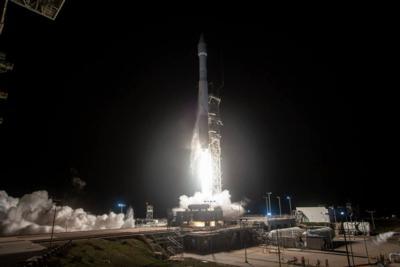Tue, Nov 15, 2022
Joint Polar Satellite System and Inflatable Decelerator Successfully Deployed
A United Launch Alliance (ULA) Atlas V rocket carrying equipment for the NOAA and NASA test gear launched from Space Launch Complex-3 at Vandenberg Space Force Base on November 10.

The launch took up the NOAA's Joint Polar Satellite System or JPSS-2. The weather analysis satellite has already entered its initial operational mode and extended its solar arrays, beginning normal activity. The JPSS-2 will circle the globe 14 times a day at an altitude of 512 miles, adding another source to the forecaster's Polar sources. Already orbiting the poles for a similar mission are JPSS-2's now-coworkers, the Suomi National Polar-orbiting Partnership (Suomi NPP) and NOAA-20 satellites.
Along for the ride was an additional piece of kit for NASA testing, the Low-Earth Orbit Flight Test of an Inflatable Decelerator, or LOFTID. The inflatable heat shield technology that could one day help land astronauts on Mars. The "aeroshell", as the system is called, could one day enable heavier payloads for difficult environments by their increased drag and low footprint when deflated. The LOFTID team will be able to review detail from the demo once recovered to decide where development should proceed.
“NOAA is an important partner for NASA in providing essential data about climate change, weather prediction, and environmental modeling for the benefit of citizens both in the U.S. and around the world,” said NASA Associate Administrator Bob Cabana. “Our Launch Services Program has successfully launched its 100th primary mission, and on this same flight enabled us to test a new technology for atmospheric re-entry with the LOFTID demonstration.”
“Exploring the unknowns of our planet to the benefit of our fellow citizens is in our DNA,” said Thomas Zurbuchen, associate administrator for NASA’s Science Mission Directorate. “The data that JPSS-2 will send back to our NASA and NOAA scientists on the ground will be critical in saving lives both on Earth and in space.”
“As partners, NOAA and NASA have successfully launched more than 60 satellite missions that have significantly improved weather forecasts, solar monitoring, and climate prediction,” said Steve Volz, director of NOAA’s Satellite and Information Service. “Launching JPSS-2 is just the latest example of what our collective agencies can achieve for the benefit of the Nation and the world at large.”
More News
He Attempted To Restart The Engine Three Times. On The Third Restart Attempt, He Noticed That Flames Were Coming Out From The Right Wing Near The Fuel Cap Analysis: The pilot repor>[...]
Make Sure You NEVER Miss A New Story From Aero-News Network Do you ever feel like you never see posts from a certain person or page on Facebook or Instagram? Here’s how you c>[...]
From 2009 (YouTube Edition): Leading Air Show Performers Give Their Best Advice for Newcomers On December 6th through December 9th, the Paris Las Vegas Hotel hosted over 1,500 air >[...]
Aero Linx: NASA ASRS ASRS captures confidential reports, analyzes the resulting aviation safety data, and disseminates vital information to the aviation community. The ASRS is an i>[...]
“For our inaugural Pylon Racing Seminar in Roswell, we were thrilled to certify 60 pilots across our six closed-course pylon race classes. Not only did this year’s PRS >[...]
 NTSB Final Report: Rutan Long-EZ
NTSB Final Report: Rutan Long-EZ ANN FAQ: Turn On Post Notifications
ANN FAQ: Turn On Post Notifications Classic Aero-TV: ICAS Perspectives - Advice for New Air Show Performers
Classic Aero-TV: ICAS Perspectives - Advice for New Air Show Performers ANN's Daily Aero-Linx (06.28.25)
ANN's Daily Aero-Linx (06.28.25) Aero-News: Quote of the Day (06.28.25)
Aero-News: Quote of the Day (06.28.25)



